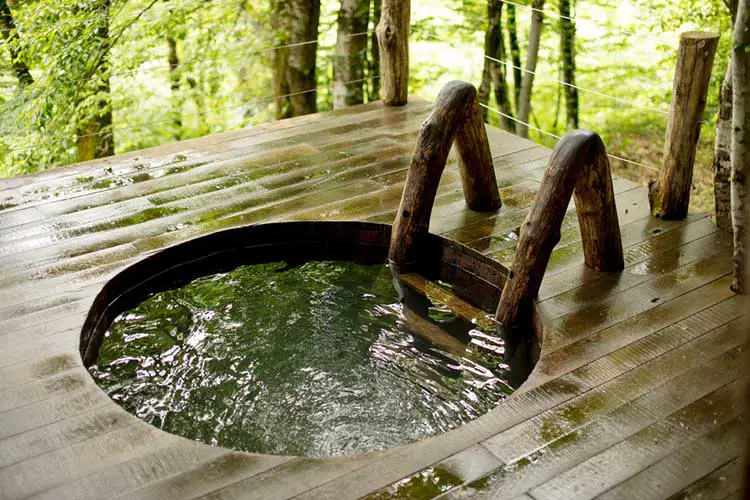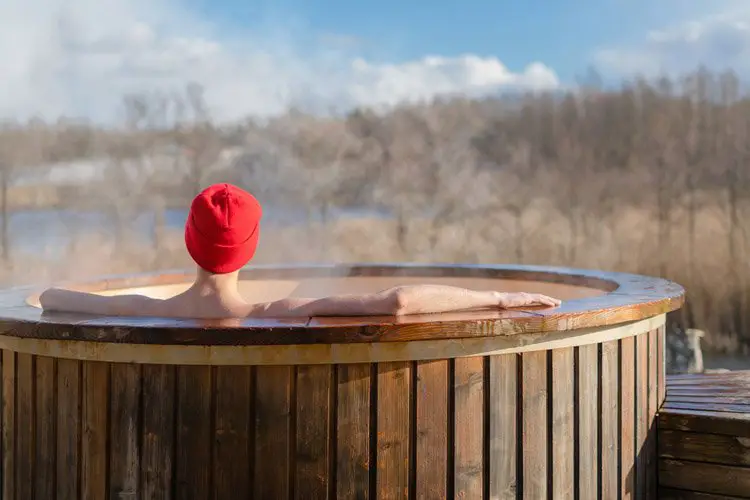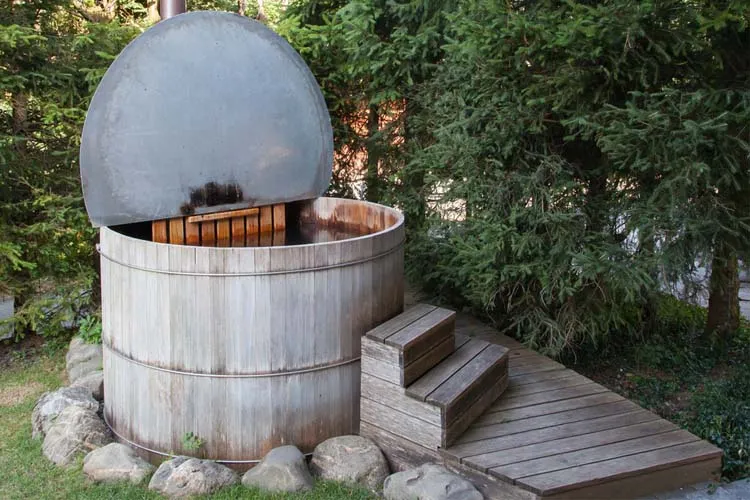Dreaming of your own hot tub to enjoy long soaks under the stars? If commercial hot tubs aren’t within reach due to budget, consider a DIY option to make your hot tub dreams come true. Soaking in a hot tub has many health benefits and can increase the value and enjoyment of your property.
Building a wooden hot tub is a satisfying project and it’s not as hard as you might think. Before you build, consider the size and shape, type of wood, and other materials you will need. You can customize the project to fit your budget and style and include features to your exact specifications.
Background
Hot tubs vary by type, size, and the materials that go into making them. From inflatable tubs to those made of plastic, ceramic, wood or stone, there are a lot of decisions to make.
Hot tubs can be electric or wood-fired and each has their pros and cons. They can also be purchased or built in a variety of shapes, sizes and aesthetic qualities.
Wooden hot tubs are popular for their rustic aesthetic and are the most traditional version of a hot tub. They can also be les expensive than their plastic or acrylic counterparts.

Best Kind of Wood to Use for a DIY Wooden Hot Tub
While you can use different types of wood for making a hot tub, certain factors make some types of wood better than others. The main feature required for building a wooden hot tub is that the wood should have adequate resistance to moisture.
Also, since most hot tubs are located outdoors the wood should have a moderate to high resistance to insect attack, rot, and mold. The wood that you use for a hot tub should also endure well in extreme weather so that you don’t have have to worry about it withstanding the elements – including blisteringly-hot summers or freezing winters.
Let’s have closer look at some of the best wood to use for your own wooden hot tub project.
Western Red Cedar (Thuja plicata)
Western red cedar is lightweight and easily available among the various softwoods. It is one of the lightest softwoods and is considered sustainable because it grows in managed forests. It is abundantly available across the United States.
Western Red Cedar will not twist and warp and it is impermeable to liquids, a primary requirement of hot tub wood. An added advantage of western red cedar is its fine color. It also offers good thermal insulation which will keep the water hot in your tub for a long time.
Alaskan Yellow Cedar (Cupressus nootkatensis)
Also known as Nootka Cypress, Alaskan yellow cedar is not a true member of the cedar family. It grows on the western slopes of the pacific coast and you will also find it growing from Southern Oregon to Alaska.
Alaskan yellow cedar is a slow-growing tree that features a tighter wood grain making it highly impermeable to water, resulting in an excellent watertight wood for a hot tub.
It is also one of the hardest cedar species in the world, making it adequately resistant to rot. It also resists insect attacks fairly well. Alaskan yellow cedar is used to make furniture, boats, decks, and of course, some excellent hot tubs. You will find it easy to work with by hand and machine tools making it a good candidate for your next DIY wooden hot tub project.
Burmese Teak (Tectona grandis)
Burmese teak is difficult to procure due to its scarcity. It is by no means a sustainable wood. Overharvesting over the years has made it into an endangered species. However, if you get hold of some legally-sourced Burmese teak, it is ideal for making a hot tub.
It is the wood that is used to build high-end boats and yachts and some of the best furniture in the world comes from Burmese teak. Burmese teak is a dense, heavy wood with a distinctive oily texture due to its high tannin content. It is highly resistant to termites and fungi. It also holds well against moisture and rot making it a prime candidate for making DIY wooden hot tubs.
Port Orford Cedar (Chamaecyparis lawsoniana)
This wood is native to the United States, particularly in the southern region of Oregon and California. Although found in these areas, Port Orford cedar is very limited in supply. But it is extremely resilient durable in terms of resistance to decay and insect attacks.
Port Orford cedar structures will last up to 25 years and it is ideal timber to use for hot tubs due to its fine texture, straight grain, and absence of splintering or raised grain.
Redwood (Sequoia and Sequoiadendron)
Redwood grows mainly in California and Oregon and has been harvested for over 400 years since the first Spanish settlers appeared. It is a highly-prized form of lumber for various applications like furniture, flooring, decking, and hot tubs.
Redwood has insect-repellent characteristics but it is a light wood that makes it easy to handle. Despite its extreme lightness, redwood is an extremely strong wood. It also has superior insulation properties making it well-suited for making hot tubs.
You will also find redwood easy to maintain. The added advantage is its red color. Today, you may not find virgin redwood easily but there is sufficient availability in the reclaimed form which you can use.
Larch (Larix decidua)
Larch is one of the heaviest types of softwood that you can find on the market. It is both tough and waterproof which makes it sufficiently durable to use for making a hot tub. It has good insulation properties which is why its favored for building in cold climates.
Larch has a fair degree of resistance to insects and rot even when in contact with the soil. Because of its slow growth, the density of larch is quite high. All these properties make larch suitable for making hot tubs.
Thermo Wood
Thermo wood or thermally modified wood is manufactured wood made through a chemical-free process. It makes it compatible with making hot tubs. It is dark wood, extremely weatherproof, and weather resistant.
Another good quality of thermos wood is its high resistance to heat. It can heat up to 232°C. It is light and stable. Thermo wood is free of resins that can contaminate the water at high temperatures. You can use it for indoor and outdoor applications.

FAQs
What is the best wood to use to build a hot tub?
Several types of natural solid wood are suitable for making hot tubs like cedar, larch, redwood, teak, and even a manufactured wood called thermo wood.
How beneficial are wooden hot tubs?
Wooden hot tubs heat up quickly, last longer, and need minimal maintenance. They also lend a rustic aesthetic to your property.
What is the life expectance of a wooden hot tub?
A wooden hot tub can last as long as 20 years.
Compared to cedar, what is a cheaper alternative for making a hot tub?
Thermo wood is a cheaper alternative to cedar for making a hot tub.
What makes hot tubs waterproof?
Moisturization is the process that makes wooden hot tubs waterproof, which needs to be done to prevent a hot tub from leaking. The wood should remain hydrated at all times. The water sometimes needs to be drained for cleaning. But do not allow the hot tub to remain dry for too long as it would shrink and cause leakage.

